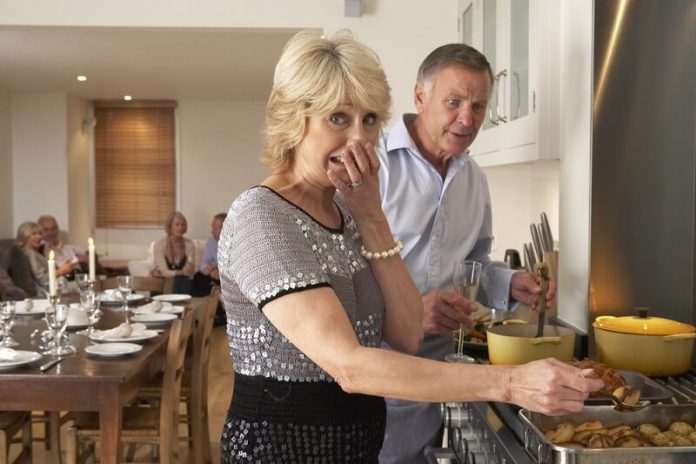This article lists 10 common mistakes that people do when cooking healthy. After looking at why some of these actions are not optimal, there are suggestions to help you improve them. Even though the title is called common healthy cooking problems and their solutions, try to think of these tips as suggestions.
Don’t worry if you can’t always follow them. A good diet is the sum of all the meals you eat and none of these things make or break a good diet. Some of the tips might be easier for you to apply than others. Every time you can improve just a small thing it is a great step.

1. Cooking vegetables right after cutting them
When you cut vegetables you break the cell walls within them. This activates certain enzymes. A lot of these enzymes start converting certain substances into more healthful ones. The heat of cooking inactivates these enzymes.
It is important to let certain cut vegetables rest before cooking so that this conversion can take place. The newly formed compounds are fairly heated stable and will not get destroyed unless you overcook the vegetables.
Similarly, compounds inside and outside the cell can mix and react with the help of some enzymes, forming new substances with healthful properties.
Solution:
In order to maximize their healthful properties, let the following vegetables rest for at least 10 minutes before cooking or consuming them: cauliflower, broccoli, brussels sprouts, cabbage, bok choy, garlic, onions, leeks, mustard greens, collard greens, and kale.
health tip
In broccoli, cauliflower, cabbage, brussels sprouts and leafy greens it is the enzyme myrosinase which converts some of the phytonutrients into their active forms. Since Vitamin C enhances the activity of this enzyme you could sprinkle some lemon juice on the cut vegetables before cooking to enhance the myrosinase activity.
2. Preparing vegetables ahead of time
While cutting vegetables a little over 10 minutes before using them is a good idea (see Tip 1.), cutting them hours or even days ahead is not optimal. Cutting vegetables increases the surface area where oxidation (contact with air) and nutrient loss can occur.
Also, cutting a vegetable is “damaging” to the plant and some of the plant’s nutrients get used up in an attempt to repair the damage. These nutrients will then not be available to you anymore when you consume the plant.
Solution:
If preparing vegetables ahead of time helps you to eat more vegetables don’t worry too much. Keep in mind that it is still better to eat them this way than not at all.
If you do not have enough time or energy to chop a lot of vegetables right before cooking, try a gadget that makes this step easier.
You could use a food processor, a mini chopper, or a mandoline slicer for example. Alternatively, try meals where chopping is not required, like baked sweet potatoes, pureed soups, and mashes, artichokes, baby carrots, etc.
3. Peeling vegetables and fruits
A lot of the nutrients are either in or right below the skin of vegetables and fruits. You obviously do not want to peel them off and throw them away!
Solution:
Don’t do it! ☺ Most of the skins of vegetables and fruits are edible. It may seem a little weird at first to eat a kiwi with its skin on for example, but eventually, you will get used to it.
If you need to remove the skin in order to make a dish work, try reusing the skin in another way. Using the skin to make a vegetable stock is one idea.
4. Boiling vegetables
While boiling vegetables in water seem like a quick and easy way to prepare them, it is actually the easiest way to lose a lot of the nutrients.
Water-soluble nutrients leech out into the water and end up being thrown away. Boiling is also an easy way to overcook vegetables and does little to improve the flavor of the vegetable.
Solution:
Try an alternative way of cooking vegetables such as roasting, steaming, broiling, stir-frying, sauteing, or grilling.
If you must boil your vegetables try to use the water in another dish to save the nutrients. You could use it in a sauce, soup or in any dish where you need some water for cooking.
5. Adding oil to pasta-water
It is a common belief that adding oil to pasta-water prevents the pasta from sticking together. Adding oil to pasta water not only does not prevent sticking, but it actually makes it harder for any sauce to adhere to the pasta later on.
Even worse, using oil in the cooking water makes it so that some fat-soluble nutrients dissolve out of the pasta and end up being tossed out with the water.
Solution:
If you want to keep your pasta from sticking together, use the following tips: Make sure you use a large pot with plenty of water so that the paste can move around.
Having the water boil at all times also keeps the paste moving. Stir the pasta with a fork every once in a while to prevent sticking. Finally, toss the pasta with sauce right after cooking.
6. Overcooking food
While you can certainly overcook foods like meat, poultry, fish, seafood, and grains, vegetables are probably one of the most commonly overcooked foods.
Not only can this make them unappealing in taste and texture (stringy asparagus, stinky cabbage, mushy carrots, etc.) but it also decreases their nutrient content. It is not uncommon to lose over 50% by overcooking vegetables.
Solution:
Instead of posting a cooking chart here (which I will definitely do at some point), I will give you some tips that you can apply to most vegetables.
Most vegetables only need to be cooked for about 3-5 minutes, 7-10 at the most (depending on the cooking method). Vegetables should still have a bite to them. Use their color or smell (cruciferous vegetables) as an indicator.
Once they start losing color, they are already overcooked. Use a kitchen timer to help remind you to take them off the heat or watch them closely the entire time they are cooking.
why does color tell us when a vegetable is “done”?
A lot of the molecules that give foods their bright colors are phytonutrients (often antioxidants) and therefore beneficial for us. Heat changes the shape of these molecules making them absorb different parts of the light spectrum. They therefore “change” in color. The structure of a molecule is also what ultimately determines its function and therefore a change in structure also means that the molecule most likely lost its beneficial properties.
7. Using olive oil to cook
Ever since the message got out that olive oil is very healthy, people have been using it as a replacement for butter and other fats in cooking.
While it is true that olive oil it is very healthy, it is not good for cooking. Polyphenols, which are the main phytonutrients in olive oil are almost completely diminished after just a couple of minutes of cooking at very high temperatures.
Also, healthy fats get oxidized during cooking and free radicals are created. The longer the cooking time and the higher the cooking temperature, the worse it is for the oil and your health.
Solution:
You would be surprised how few recipes actually need oil during the cooking process. Most of the time you can use broth instead of oil to saute vegetables etc.
Since fats are important for carrying flavor molecules and for making certain nutrients more bio-available, it is a good idea to add some oil after cooking.
Simply stir in some oils into soups, sauces and pour some over vegetables and grains before serving. This way the oil will not only taste better but you can benefit from all its healthful properties.
8. Under seasoning food
In healthy cooking, you can’t use a ton of fat or salt to make foods taste better. You rely much more on herbs, spices, and seasonings to make things taste good.
Most spices, herbs, and seasonings have unique health properties and will not only make a dish taste better but also healthier.
Solution:
You can learn about seasonings foods in books or simply go into the kitchen and experiment! Nobody is born knowing what flavors go well together and what the right quantity of spice is for a certain dish.
The more you practice the better you will get and the better your food will ultimately taste and be for you.
did you know… ?
Seasonings and spices have even been shown to reduce the risk of food poisoning. The more antioxidants a food contains, the greater its ability to inhibit bacterial activity. Oregano, cloves and cinnamon are among the most effective. Rosemary, thyme, nutmeg, and bay leaves are also extremely rich in antioxidants.
9. Charring vegetables and meats
Grilling is often thought of as a healthy cooking method since it reduces the need for oil. But due to the high temperature, meats and even vegetables often become charred.
This of course can also occur in the oven or in a pan. Charring is not only is a sign that nutrients have been destroyed, but harmful free radicals and carcinogens are created in the process.
Solution:
Charring or searing food gives it a special taste and is therefore often desired. It is ok to eat these foods once in a while, but if you find yourself eating mostly blackened or seared foods, you may want to try alternative cooking methods.
Try cooking something in a flavorful broth, steaming, sauteing or baking at a low temperature.
10. Not washing produce properly
While most people wash produce that will be enjoyed whole, other fruits and vegetables that will be peeled are often not.
Harmful bacteria that sits on the outside can easily be transferred to the inside when the product is cut. You can also spread the bacteria with your hands when handling the produce.
Solution:
It is important to wash fruits and vegetables under running water before handling them. Also, make sure you throw away the outermost leaves of cabbages and lettuces since they are the most likely to be contaminated.
While food poisoning is an annoyance for most people, it can be more serious for the elderly, young children, or people with compromised immune systems.
In rare cases, unlucky people have also lost limbs or even died due to bacterial infections from food (through cuts). While these cases are relatively rare it is better to be safe than sorry.
I hope you were able to find some tips that will be helpful to you! Again, when trying to eat healthily, every step in the right direction is a good step.

